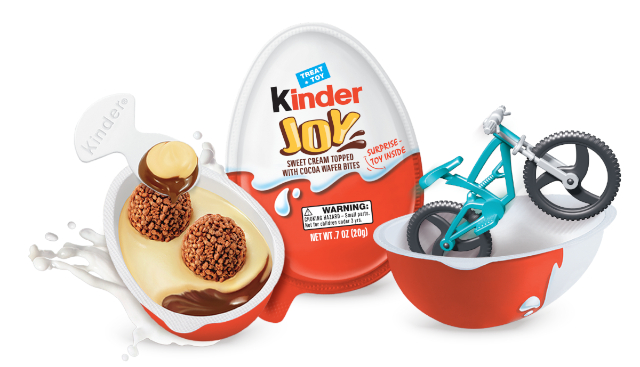A globally popular children’s chocolate treat, the Kinder Egg, has been called back to the store by maker Ferrero after salmonella outbreaks in dozens of countries racked up more than 450 known cases of food poisoning. But the recall is being called too little, too late by some industry observers…
 The new, re-engineerd Kinder Egg, which débuted in North America in 2018.
The new, re-engineerd Kinder Egg, which débuted in North America in 2018.
According to an article just this week in Food Safety News (FSN), the original recall on Kinder Egg chocolate confections, was issued back in April. Operations at the Belgian factory where Kinder Eggs are made was suspended back in early spring, after the implicated product had already been distributed in 113 countries world-wide. The first case was reported back on January 17, 2022. Since then, more than 450 known cases of Salmonela poisoning have surfaced, linked to the chocolate treat. Most of those have been in children under 10 years of age, and many have required hospitalization.
The UK has had the most confirmed cases with 128, followed by France with 121, Belgium with 66, Switzerland with 49, 34 in Germany, 18 in Ireland and 14 in Austria. Canada still has 4 active cases and there’s one in the U.S. Sweden, Spain, Norway, Netherlands, Luxembourg, Italy, Denmark and Czech Republic have all reported single-figure case numbers.
What’s happened at the plant
Food Safety News reports, “About 1,000 Ferrero employees and independent specialists worked on the restart. More than 1,800 quality tests were completed and 10,000 parts dismantled and cleaned. Investments included replacing multiple pieces of equipment and installing 300 meters of new pipeline. About 1,000 Ferrero employees and independent specialists worked on the restart. More than 1,800 quality tests were completed and 10,000 parts dismantled and cleaned. Investments included replacing multiple pieces of equipment and installing 300 meters of new [chocolate pumping] pipeline.”
The Belgian Federal Agency for the Safety of the Food Chain (FASFC) gave conditional approval for the plant to restart production in June.
Okay. But why are we only hearing about this potentially catastrophic food poisoning disaster now?
Why the delay?
I’m aghast that the masses are only hearing about the recall now, more than 6 months after it first surfaced. And more than a month after the plant was given the green light to restart production.
This situation is unprecedented in my experience as a chef and a food blogger. It’s as though the Belgian government, and maybe other governments, were conniving with Ferrero to keep the story quiet. Maybe it’s just my old reporter’s smell test that’s been triggered. And I’ll admit I may be more sensitive to whiffs of conspiracy than most. Another hazard of the job.
My take
No matter what the circumstances and chain of events behind the delay in publicising the recall, I’m amazed – and relieved – that the number of known cases around the world has remained under 500. The FSN story notes that some of the effected countries have advanced lab instruments able to detect Salmonella via its molecular footprint, but many others do not. And that, the European Centre for Disease Prevention and Control (ECDC) says, may have resulted in many other cases not being positively linked to the Ferrero product.
I’m also wondering how common this business of keeping food poisoning outbreaks quiet may be within industry and government circles. Ferrero is one of the world’s largest confectioners and choclatiers, and it owns a bunch of major brands including Ferrero Rocher, Tic Tac, Kinder, Nutella, Butterfinger, Crunch, Baby Ruth, and Fannie May. From a political standpoint, it would makes sense that officials would be motivated to keep such an important corporate citizen happy.
But I have to allow myself a wry grin when I recall that Ferrero had to massively re-engineer its popular Kinder Egg in 2017 to isolate non-chocolate components (small plastic toys) from the edibles.The production lines and packaging process underwent massive changes to accommodate the update demanded by government health and safety officials who were concerned kids might get sick from eating the treat.
And after all that, it was a relatively simple, old fashioned Salmonella outbreak that sidelined the brand.
~ Maggie J.

